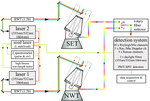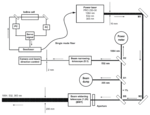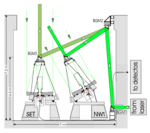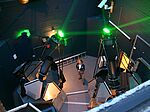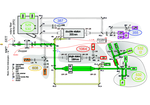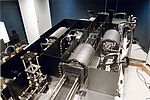The ALOMAR Rayleigh/Mie/Raman lidar
Since 1994 the Rayleigh/Mie/Raman (RMR-)Lidar has been operated on the island of Andøya in Northern Norway as part of the Arctic Lidar Observatory for Middle Atmosphere Research (ALOMAR). It has been a cooperation of the Leibniz-Institute of Atmospheric Physics and the Service d'aéronomi of the Centre National de la Recherche Scientifique in Guyancourt (France). The RMR lidar is used to study temperatures and winds in the middle atmosphre, aerosol layers in the stratosphere, polar stratospheric clouds in the lower stratosphere in winter and noctilucent clouds in the mesopause region in sommer.
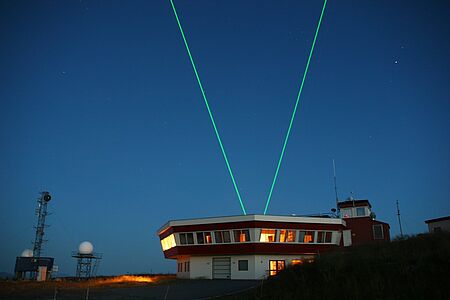
Technical design
The ALOMAR RMR lidar is a twin-lidar system consisting of two power lasers, two receiving telescopes and one optical bench for verification of the light received from the atmosphere. A schematic overview of the lidar system is given in Figure 1.
The power lasers are pulsed Nd:YAG lasers emitting the fundamental (1064 nm), second (532 nm) and third (355 nm) harmonic wavelengths simultaneously. Each laser works with a repetition rate of 30 Hz, in case of both lasers working simultaneously they are triggered alternately on a pulse-by-pulse basis. Both power lasers are seeded by a single external cw-laser which is frequency stabilized by iodine absorption spectroscopy to keep a relative wavelength stability of Δλ/λ = 10-9. Due to the seeding the lasers produce pulses with a high spectral stability and short pulse length (approx. 10 ns). Using beam direction stabilization systems on the laser tables the laser beams are guided into beam widening telescopes (BWT) for reduction of the beam divergence by a factor of 20. Figure 2 shows the design of the laser system with power laser, seeder laser and beam widening telescope. After that the beams now having a diameter of 20 cm each are guided by a second set of beam direction stabilization systems using three beam guiding mirrors to emit the beam coaxially to the telescopes into the atmosphere (see Figure 3).
To collect the backscattered light from the atmosphere two telescopes (quasi-cassegrain-design) with 1.8 m primary mirrors are used which can be tilted up to 30° off-zenith. They are installed that one telescope is able to access the north-to-west quadrant, the other one the south-to-east quadrant. A schematical drawing of the telescopes and the laser beam paths in the telescope hall is shown in Figure 3. The picture in Figure 4 shows the view from above into the telescope hall with the two telescopes. The South-East telescope (SET, left) is tilted 20° to the East while the North-West telescope (NWT, right) is titled 20° to the North. The protective covers of both telescopes are open and one can see the green laser beams. Using the two telescopes different combinations of viewing directions are possible for observations like simultaneous and common-volume measurements with rocketborn in situ experiments and studies of the horizontal structure of NLC. Besides horizontal wind measurements are possible.
For investigations of the polarization characteristics of the light in the visible (532 nm) and ultraviolet (355 nm) spectral range turnable polarizers are integrated in the focal optics of the receiving telescopes which can be used when needed. The light received from the atmosphere is guided by optical fibers to the input optics of the optical bench.
At the input of the optical bench (see drawing in Figure 5) a rotating segmented mirror (fiber selector) is used to feed the light of both telescopes synchronized to the laser pulses into the single set of receiving optics. A rotating chopper blade blocks the strong signal from the troposphere to prevent detector overload. The light is separated and filtered by spectral range and intensity to measure with 18 different detectors (details see Table 1). Using photomultipliers (PMT) and avalanche photodiodes (APD) the collected light is converted into electrical signals which are altitude resolved by counters.
The detectros for the three laser wavelengths can be operated all year and under daylight conditions due to strong spatial and spectral filtering by a small telescope field-of-view (96 μrad), interference filters and actively stabilized Fabry-Perot-Interferometer (etalons) having a bandwidth of 10 and 4 pm respectively. The picture in Figure 6 shows the etalons together with other parts of the optical bench.
The whole lidar is automated to a large extent allowing to operate it by a single trained operator. Our Norwegian colleagues operate the RMR lidar whenever permitted by the weather. This is essential for the acquisition of extensive data sets for climatological investigations of the polar middle atmosphere. A more detailed description of the system can be found in the article by von Zahn et al. [2000].
| Wavelength | Numbers | Scattering | Particle |
|---|---|---|---|
| 1064 nm | 2 | Rayleigh & Mie | air molecules and aerosols |
| 532 nm | 3 | Rayleigh & Mie | air molecules and aerosols |
| 355 nm | 3 | Rayleigh & Mie | air molecules and aerosols |
| 608 nm (excited by 532 nm) | 2 | Vibrations-Raman scattering | N2-molecules |
| 387 nm (excited by 355 nm) | 1 | Vibrations-Raman scattering | N2-molecules |
| 530 nm & 529 nm (excited by 532 nm) | 2 | Rotations-Raman scattering | N2- and O2-molecules |
| Wind | |||
| 532 nm | 3 | Rayleigh & Mie | air molecules and aerosols |
| System Monitoring | |||
| 532 nm & 355 nm | 2 |
Selected publications
- I. Strelnikova, M. Almowafy, G. Baumgarten, K. Baumgarten, M. Ern, M. Gerding and F.-J. Lübken, Seasonal cycle of gravity wave potential energy density from lidar and satellite observations at 54° and 69°N, J. Atmos. Sci., 78, 1359-1386, doi:10.1175/JAS-D-20-0247.1, 2021.
- B. Schäfer, G. Baumgarten and J. Fiedler, Small-scale structures in noctilucent clouds observed by lidar, J. Atmos. Solar-Terr. Phys., 208, doi:10.1016/j.jastp.2020.105384, 2020.
- A. Langenbach, G. Baumgarten, J. Fiedler, F.-J. Lübken, C. von Savigny and J. Zalach, Year-round stratospheric aerosol backscatter ratios calculated from lidar measurements above Northern Norway, Atmos. Meas. Tech., 12, 4065-4076, doi:10.5194/amt-12-4065-2019, 2019.
- J. Hildebrand, G. Baumgarten, J. Fiedler and F.-J. Lübken, Winds and temperatures of the arctic middle atmosphere during January measured by Doppler lidar, Atmos. Chem. Phys., 17(21), 13345-13359, doi:10.5194/acp-17-13345-2017, 2017.
- G. Baumgarten, Doppler Rayleigh/Mie/Raman lidar for wind and temperature measurements in the middle atmosphere up to 80 km, Atmos. Meas. Tech., 3, 1509-1518, doi:10.5194/amt-3-1509-2010, 2010.












